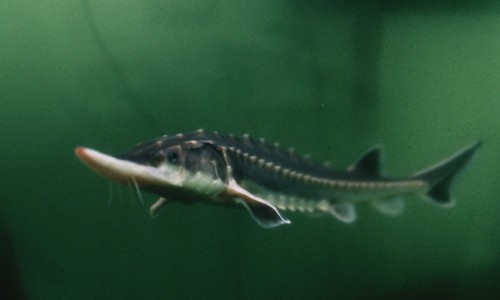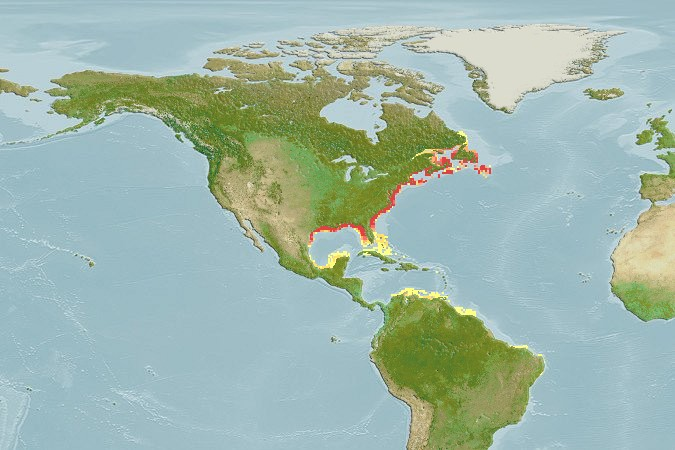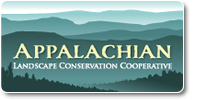Atlantic Sturgeon
Atlantic Sturgeon (Acipenser oxyrhynchus)

Photo credit: Virginia Institute of Marine Sciences
Life History and Habitat Needs
The Atlantic sturgeon is a long-lived, estuarine dependent, anadromous fish. Atlantic sturgeon can grow to approximately 14 feet (4.3 m) long and can weigh up to 800 lbs (370 kg). They are bluish-black or olive brown dorsally (on their back) with paler sides and a white belly. They have five major rows of dermal "scutes".
Atlantic sturgeon are similar in appearance to shortnose sturgeon (Acipenser brevirostrum), but can be distinguished by their larger size, smaller mouth, different snout shape, and scutes.
Atlantic sturgeon have been aged to 60 years. There is generally faster growth and earlier age at maturation in more southern populations. For example, Atlantic sturgeon mature in South Carolina rivers at 5-19 years of age, in the Hudson River at 11-21 years, and in the Saint Lawrence River at 22-34 years.
Geographic Range: According to the National Oceanic and Atmospheric Administration’s National Marine Fisheries Service, historically, Atlantic sturgeon were present in approximately 38 rivers in the United States from St. Croix, ME to the Saint Johns River, FL, of which 35 rivers have been confirmed to have had a historical spawning population. Atlantic sturgeon are currently present in approximately 32 of these rivers, and spawning occurs in at least 20 of them.


Native Distribution Map for Acipenser oxyrinchus (Atlantic sturgeon) modeled future range map based on IPCC A2 emissions scenario www.aquamaps.org, Aug. 2013. Web. Accessed 18 Mar. 2014. Distribution: Western Atlantic: Hamilton River, Labrador, Newfoundland, Canada to northeastern Florida,USA. Occurs occasionally in Bermuda, French Guiana and N. Gulf of Mexico.
Movement/Migration and Spawning: Sturgeons are anadromous, meaning they live in the ocean and spawn in freshwater rivers. Spawning occurs from April-June in the freshwater river where the fish was born. The fish then only typically returns to its spawning ground every 3-5 years. Females can lay up to 2 million eggs, which are large and black and stick to the bottom of the river. After laying their eggs, females leave their spawning areas, while males remain there until autumn. Once hatched, juveniles stay in their natal river for as long as six years before moving into open waters and eventually the ocean. Males do not reach sexual maturity until they are at least 10 years old. Females take nearly 20 years to mature. Atlantic sturgeon can live for more than 60 years.
Dr. Douglas Peterson and students at the University of Georgia are assessing the current spawning stock status of Atlantic sturgeon in the Altamaha River to determine abundance, sex ratio, and age-structure of the spawning population, survey juvenile abundance to determine recent recruitment trends, and identify and describe essential habitats of different life stages of Atlantic sturgeon (i.e., juvenile, sub adult, and adult) in the Altamaha River. They are also evaluating population trends since the 1996 closure of the Atlantic sturgeon fishery.
Habitat Use: Atlantic sturgeon are "anadromous"; adults spawn in freshwater in the spring and early summer and migrate into "estuarine" and marine waters (saltwater) where they spend most of their lives. In some southern rivers a fall spawning migration may also occur. They spawn in moderately flowing water (46-76 cm/s) in deep parts of large rivers. Sturgeon eggs are highly adhesive and are deposited on bottom substrate, usually on hard surfaces (e.g., cobble). It is likely that cold, clean water is important for proper larval development. Once larvae begin migrating downstream they use benthic structure (especially gravel matrices) as refuges. Juveniles usually reside in estuarine waters for months to years. Subadults and adults live in coastal waters and estuaries when not spawning, generally in shallow (10-50 m depth) nearshore areas dominated by gravel and sand substrates. Long distance migrations away from spawning rivers are common. They tend to travel alone, rather than in schools.
Fun Facts:
- Sturgeons are prehistoric fish that have existed for more than 120 million years. They were around during the Cretaceous period, when dinosaurs roamed the earth.
- Part of the Atlantic sturgeon’s scientific name, oxyrhynchus, means “sharp snout.”
- Sturgeons are the largest fish native to the Chesapeake Bay.
- The largest Atlantic sturgeon ever recorded was caught in Canada. It measured 14 feet long and weighed 811 pounds.
- Sturgeons were abundant when English settlers arrived in the Bay region in the 1600s. They were a reliable source of food for the settlers most of the year.
- Sturgeons supported an important fishing industry from colonial times to the early 20th century. In particular, caviar from sturgeon eggs was considered a delicacy in Europe.
- Sturgeons are very sensitive to low oxygen, pollution and other poor water conditions. This, combined with their slow rate of maturity, damming of their spawning rivers and historic commercial fishing pressure, has caused the species to become very rare.
- The National Oceanic and Atmospheric Administration officially declared the Atlantic sturgeon an endangered species in 2012. It is illegal to fish for, catch or harvest Atlantic sturgeon or their eggs.
Text taken from the NOAA Fisheries Office of Protected Resources online fact sheet, November 2013 and Chesapeake Bay Program online fact sheet.
Habitat Restoration Efforts
The following summaries are some of the on-the-ground habitat restoration projects that benefit Atlantic sturgeon and that have been funded by the Eastern Fish Habitat Partnerships (FHPs) with support from USFWS or NOAA and implemented through state and/or local partnerships:
Deadman's Island Restoration Project
Lead by the City of Gulf Breeze, this project will restore coastal barrier habitat on Deadman's Island.
Habitat Restoration to Benefit Rare Species and Natural Communities in the Altamaha River Watershed
Cool water springs feeding major coastal rivers in Georgia provide critical thermal refuges during summer for diadromous fishes such as striped bass. However, the connectivity of many of these springs to the main rivers has been diminished by drought and sediment.
Oconee River Gravel Bar Habitat Enhancement (Phase I)
The robust redhorse (Moxostoma robustum), a species that had been lost to science for about 150 years, was discovered on the Oconee River in 1991. Wild populations subsequently found in the Savannah River (Georgia/South Carolina) and Pee Dee River (North Carolina).
Crabtree Swamp Habitat Restoration
The restoration of Crabtree Swamp is an innovative, "first of its kind" project, in which a previously channelized drainage basin is being returned to a blackwater hardwood swamp in which the floodplain is being recreated via earthmoving and replanting into functional habitat for fish, invertebrates and other wildlife. To match resources, the restoration project has been subdivided into 10 reaches.
Gravel Augmentation at Spawning Habitats in the Oconee and Ogeechee Rivers of Georgia
The robust redhorse (Moxostoma robustum), a species that had been lost to science for about 150 years, was discovered on the Oconee River in 1991. Wild populations subsequently found in the Savannah River (Georgia/South Carolina) and Pee Dee River (North Carolina) have been augmented by stocking in other areas of Georgia and South Carolina. The species is very particular about the water quality and depth as well as the gravel quality of its spawning sites. To encourage propagation of this native species, the Robust Redhorse Conservation Committee coordinates activities in several southeastern states. The gravel augmentation is expected to benefit invertebrates, including mussels, as well as anadromous species such as striped bass, American shad, and Atlantic sturgeon.
Improved Red Drum Habitat through Community-based Oyster Reef Habitat Restoration
Little has been attempted to improve the habitat to ensure survival of stocked red drum fingerlings in SC waters This project will create additional oyster reefs in stocking areas. The impact will be many fold as other organisms will utilize the habitat and oyster population and water quality improvements will be recognized. Patches of hard substrate and 3-D reefs will be created in stocking areas, thus establishing quality habitat for red drum at this early life stage.
Cape Fear River Fisheries Enhancement Project
This project, lead by Cape Fear River Watch, will restore .5 acres of fish habitat by placing approximately 1,000 tons of crushed granite rock (over 2,000 cubic yards, .5 acres downstream of lock and dam #2) in the Cape Fear River below Lock & Dam No. 2 in Bladen County, North Carolina.
Monitoring selected water quality parameters on the Saint Marys River addressing NFHAP goals
Water quality monitoring on the Saint Marys River is undertaken by multiple conservation and regulatory agencies including. Periodic or grab sampling utilized to date may miss suspected short-term degradations of water quality associated with water flows of storm events. Three Hydrolab sonde units will be placed near the river's bottom to collect data over at least eight months of the year.This time series data will include measurements on oxygen, pH, temperature and salinity and others.
Restoring Diadromous Fish Passage and Habitat to Shoreys Brook, Maine
This project, located in South Berwick, ME will restore approximately 800 feet of habitat for diadromous fish species and enhance approximately 4.3 miles of habitat in Shoreys Brook. A partially‐breached dam was completely removed and the stream bed was restored to its approximate original condition. A failing perched culvert will be restored with an open‐arch culvert in the summer of 2012.
Spotlight on James River Atlantic Sturgeon Habitat Restoration, Virginia
A lack of clean, hard substrate has been noted as a limiting factor for the restoration of many anadromous species in the James River. The loss of this ideal spawning habitat is due to dredging and excess sediment entering the river from erosion. This project will promote the population of Atlantic sturgeon (Acipenser oxyrinchus oxyrinchus) and other anadromous fishes of the Chesapeake Bay through the restoration of spawning and nursery habitat.
Shoreline and Spartina Marsh stabilization along the Atlantic Intracoastal Waterway, South Carolina
This project will rehabilitate tidal marsh areas experiencing degradation from boat traffic along the Intracoastal Waterway, within the ACE Basin National Estuarine Research Reserve, by constructing natural breakwaters using oyster reefs. The expected results of the project include: increased fish habitat, stabilized shoreline, improved water quality, and increased public awareness.
Document Actions






